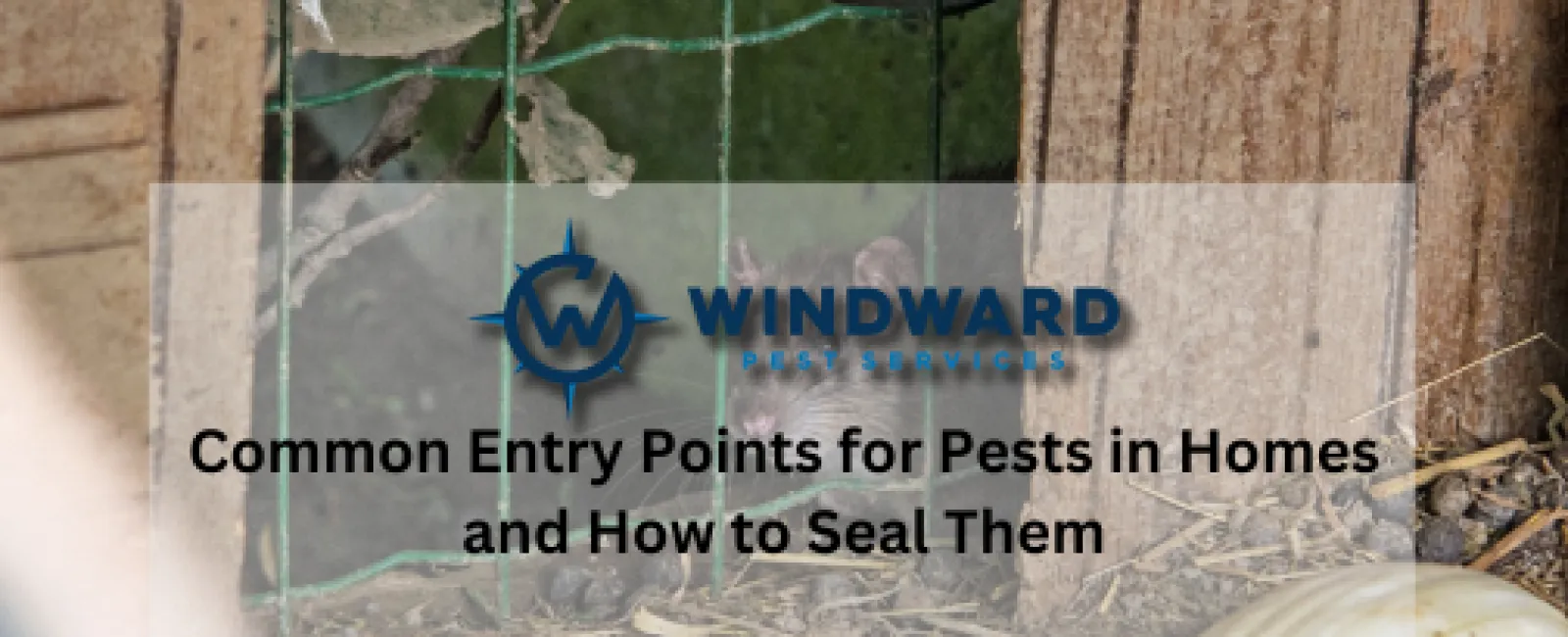Pests are a persistent problem for homeowners across Georgia. From ants and cockroaches to rodents and termites, these unwelcome intruders can cause significant damage to property and pose health risks to your family. Understanding how pests enter your home is the first step in preventing infestations. Many homeowners might not realize that their homes have various vulnerabilities, offering pests easy access.
At Windward Pest Services, we specialize in Atlanta pest control and offer comprehensive Atlanta interior and exterior pest treatments. By identifying and addressing these common entry points, you can protect your home from Georgia pests. Whether you're dealing with a current infestation or want to take preventive measures, understanding the ways pests gain access to your home is crucial. In this article, we will explore the most common entry points for pests and provide detailed guidance on how to effectively seal them.
Our team of experts provides thorough Windward Pest Services pest inspections, ensuring that your home remains a safe and pest-free environment. With our extensive experience in Atlanta residential and commercial pest services, we have identified key vulnerabilities in homes across Georgia that pests commonly exploit. By sealing these entry points, you can significantly reduce the likelihood of a pest infestation.
Common Entry Points for Pests
Doors and Windows - Doors and windows are among the most obvious entry points for pests. However, even when these openings are closed, pests can still find their way inside through small gaps, cracks, or damaged weatherstripping. Termites, ants, and even rodents can slip through these tiny openings. Regular inspections of your door and window seals are essential for pest prevention.
To address this, check the weatherstripping around your doors and windows. Replace any worn or damaged seals to ensure a tight fit. Additionally, consider installing door sweeps to eliminate gaps at the bottom of exterior doors, which are often overlooked as potential entry points for pests. Atlanta pest control experts at Windward Pest Services can help identify vulnerable areas during pest inspections and offer solutions to keep pests out.
Cracks in the Foundation - The foundation of your home can develop cracks over time due to settling, temperature changes, and moisture. These cracks, even if they seem minor, can provide easy access for pests like termites, ants, and spiders. A thorough inspection of your home's foundation is necessary to spot these vulnerabilities.
To prevent pests from entering through foundation cracks, use caulk or a concrete patch to seal them. Be sure to check for cracks not only on the exterior foundation but also inside your basement or crawlspace. During Atlanta interior and exterior pest treatments, Windward Pest Services can recommend the best sealants and repair methods for your home's foundation.
Vents and Utility Lines - Vents and utility lines are essential components of any home, but they also create entry points for pests. Dryer vents, attic vents, and even your HVAC system can offer easy access to your home for small pests like insects and rodents. Similarly, utility lines such as plumbing and electrical conduits often have gaps around them where pests can squeeze through.
To address these issues, inspect all vents for damage or gaps and install fine mesh screens over them to prevent pests from entering. For utility lines, seal the gaps around them with a weather-resistant caulk or foam insulation. Our Windward Pest Services pest inspections include checking these areas for signs of pest activity and recommending sealing methods that are appropriate for Georgia's climate.
Chimneys - Chimneys can be a significant entry point for pests, especially birds, squirrels, and bats. These pests can cause damage to your home and create health hazards if they nest inside your chimney or attic. Installing a chimney cap is a simple and effective way to prevent pests from entering your home through this route.
A chimney cap acts as a barrier, allowing smoke to escape while keeping pests out. It's important to have your chimney regularly inspected to ensure the cap is in good condition and that there are no gaps around it. Windward Pest Services can provide advice on the best chimney caps for your home as part of our Atlanta residential and commercial pest services.
Roof and Eaves - The roof is another critical area where pests can gain entry to your home. Damaged shingles, loose flashing, and gaps in the eaves can provide openings for pests like squirrels, raccoons, and insects. Additionally, overhanging tree branches can act as bridges for pests, giving them easy access to your roof.
Regular roof maintenance is essential for preventing pest infestations. Trim back tree branches that are too close to your home, and inspect your roof for damage after storms or high winds. Sealing gaps in the eaves with caulk or wire mesh can also help keep pests out. As part of our Atlanta pest control services, Windward Pest Services offers inspections and treatments designed to protect your roof and attic from pest invasions.
Garages and Basements - Garages and basements are often overlooked when it comes to pest prevention, but they can be major entry points for pests. Cracks in the floor, gaps under doors, and clutter can all attract pests to these areas. Once inside, pests can easily make their way into the rest of your home.
To seal entry points in your garage and basement, start by clearing out clutter and removing potential hiding spots for pests. Inspect the walls and floors for cracks and seal them with caulk or concrete patch. Installing door sweeps on garage doors can also help prevent pests from sneaking in. Windward Pest Services can help you identify and address these issues during a pest inspection.
Sealing Techniques and Materials
The key to effectively sealing entry points is using the right materials for the job. Some common sealing techniques include:
Caulking: Caulk is ideal for sealing small cracks and gaps around windows, doors, and utility lines. Choose a weather-resistant caulk to ensure durability.
Expanding Foam: Expanding foam is excellent for filling larger gaps around pipes, utility lines, and foundation cracks. It provides an airtight seal that pests can't penetrate.
Weatherstripping: Weatherstripping helps seal gaps around doors and windows. Replace old or damaged weatherstripping to ensure a tight seal.
Wire Mesh: Wire mesh is useful for covering vents, chimneys, and other openings. Make sure to choose a fine mesh that pests can't squeeze through.
At Windward Pest Services, we provide expert advice on the best sealing methods and materials for your home. Our Atlanta interior and exterior pest treatments include targeted solutions to protect your home from pests year-round.
Protecting your home from pests starts with identifying and sealing the entry points they use to gain access. By taking proactive measures and addressing vulnerabilities, you can prevent costly infestations and keep your home safe. At Windward Pest Services, we specialize in Atlanta pest control and offer comprehensive Atlanta residential and commercial pest services to help homeowners throughout Georgia safeguard their properties.
From doors and windows to foundation cracks and utility lines, there are many potential entry points for pests in your home. Our team of experts provides thorough pest inspections and treatments, ensuring that every vulnerability is addressed. With our help, you can enjoy peace of mind knowing that your home is protected from Georgia pests.

